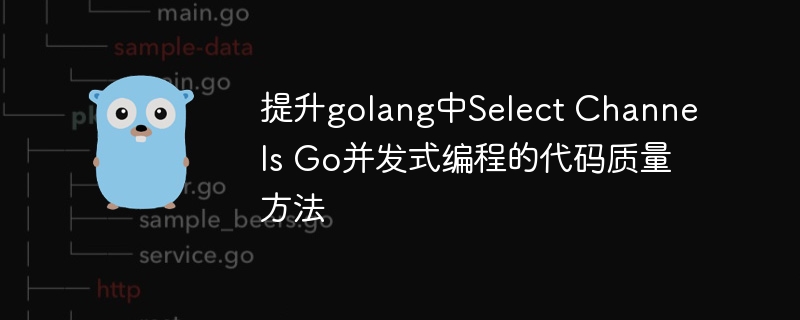

Methods to improve the code quality of Select Channels Go concurrent programming in Golang
Introduction:
Golang is a powerful programming language that is particularly good at handling concurrency. Among them, the select statement and channel mechanism are widely used in concurrent programming, providing us with an elegant and efficient way to deal with concurrency issues. However, when writing concurrent code, there are some common pitfalls and issues we need to be aware of to ensure the quality and reliability of our code. This article will introduce some methods to improve the quality of concurrent code written using Select and Channels in Golang, and provide specific code examples for reference.
1. Avoid deadlock
Deadlock is a common problem when using Channels and select statements. To avoid deadlock, we need to ensure that each goroutine can successfully send and receive data. Here are some ways to avoid deadlocks:
Use a buffered Channel: When declaring a Channel, you can set a buffer size to ensure that send and receive operations can be performed immediately. For example:
ch := make(chan int, 1) // 声明带有缓冲区大小为1的Channel
Use the default branch of the select statement: By adding the default branch to the select statement, you can perform the default action when data cannot be sent or received. For example:
select {
case ch <- data:
// 发送数据成功
case <-time.After(time.Second):
// 超时处理
default:
// 默认操作
}Use send and receive with timeout: Use the timer in the time package to set the timeout for the send or receive operation. For example:
select {
case ch <- data: // 发送数据
case <-time.After(time.Second): // 在1秒后执行超时处理
}2. Reasonable use of select statements
When writing code with select statements, you need to pay attention to some best practices to ensure the readability and efficiency of the code .
Processing only one Case: Each select statement can only process one case, so processing multiple cases in one select statement often leads to code confusion. If you need to handle multiple cases, they should be divided into multiple select statements. For example:
select {
case <-ch1:
// 处理Case 1
case <-ch2:
// 处理Case 2
}
select {
case <-ch3:
// 处理Case 3
case <-ch4:
// 处理Case 4
}Use the default branch for non-blocking operations: When using the select statement, you can set a certain case to a non-blocking operation to ensure that the code will not fail due to a certain case. execution is blocked. For example:
select {
case <-ch1:
// 处理Case 1
case <-ch2:
// 处理Case 2
default:
// 非阻塞操作
}Use for loop and break exit: When using a select statement, you can wrap it in a for loop to execute the select statement multiple times. Use the break statement to exit a loop when a certain condition is met. For example:
for {
select {
case <-ch1:
// 处理Case 1
case <-ch2:
// 处理Case 2
case <-done:
// 退出循环
break
}
}3. Use channels for data sharing and synchronization
The following is a sample code that demonstrates how to use Channel for data sharing and synchronization:
func worker(id int, jobs <-chan int, results chan<- int) {
for j := range jobs {
result := j * 2
results <- result
}
}
func main() {
numJobs := 10
jobs := make(chan int, numJobs)
results := make(chan int, numJobs)
// 启动worker goroutine
for w := 1; w <= 3; w++ {
go worker(w, jobs, results)
}
// 发送任务到jobs Channel
for j := 1; j <= numJobs; j++ {
jobs <- j
}
close(jobs)
// 接收结果
for r := 1; r <= numJobs; r++ {
result := <-results
fmt.Println(result)
}
}In the above code, we use two Channels to achieve data sharing and synchronization . jobs Channel is used to receive tasks, and results Channel is used to receive processing results. Use the go keyword to start multiple worker goroutines to process tasks and send the results to the results Channel. In the main function, we send the task to the jobs Channel and receive the processing results in the result Channel.
Conclusion:
In Golang, using the select statement and Channel mechanism for concurrent programming is a very powerful and flexible way. By avoiding deadlocks, rationally using select statements, and using Channels for data sharing and synchronization, we can improve the quality and reliability of Golang's concurrent code. At the same time, attention needs to be paid to selecting appropriate concurrency models and scheduling strategies to meet actual needs and performance requirements.
Reference:
The above is the detailed content of Methods to improve the code quality of Select Channels Go concurrent programming in golang. For more information, please follow other related articles on the PHP Chinese website!
 How to define variables in golang
How to define variables in golang
 What are the data conversion methods in golang?
What are the data conversion methods in golang?
 What are the commonly used libraries in golang?
What are the commonly used libraries in golang?
 What is the difference between golang and python
What is the difference between golang and python
 What are the main characteristics of computers?
What are the main characteristics of computers?
 How to fix libcurl.dll missing from your computer
How to fix libcurl.dll missing from your computer
 Introduction to the usage of vbs whole code
Introduction to the usage of vbs whole code
 Laravel Tutorial
Laravel Tutorial
 Ranking of the top ten digital currency exchanges
Ranking of the top ten digital currency exchanges




